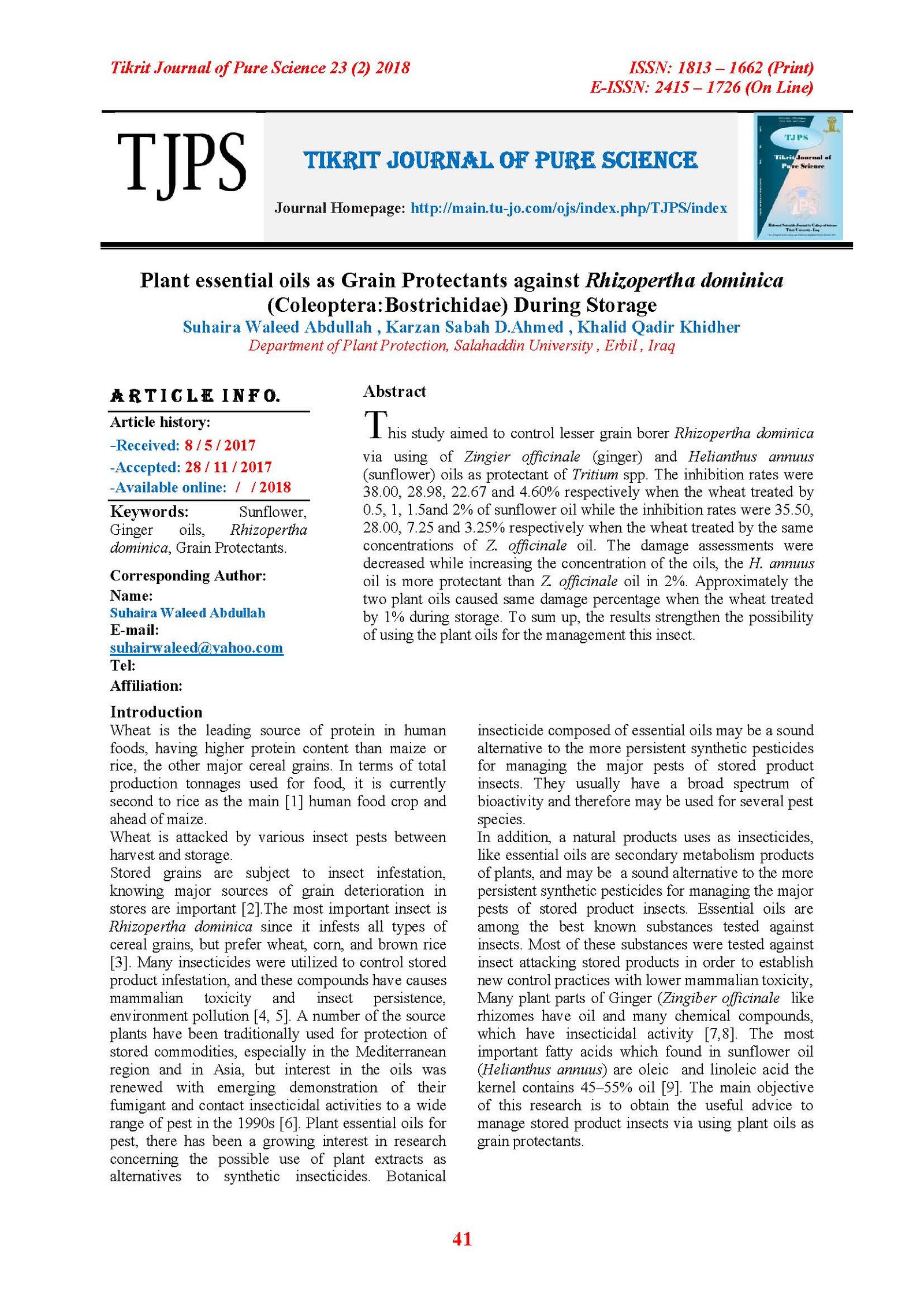Plant essential oils as Grain Protectants against Rhizopertha dominica (Coleoptera:Bostrichidae) During Storage
Main Article Content
Abstract
This study aimed to control lesser grain borer Rhizopertha dominica via using of Zingier officinale (ginger) and Helianthus annuus (sunflower) oils as protectant of Tritium spp. The inhibition rates were 38.00, 28.98, 22.67 and 4.60% respectively when the wheat treated by 0.5, 1, 1.5and 2% of sunflower oil while the inhibition rates were 35.50, 28.00, 7.25 and 3.25% respectively when the wheat treated by the same concentrations of Z. officinale oil. The damage assessments were decreased while increasing the concentration of the oils, the H. annuus oil is more protectant than Z. officinale oil in 2%. Approximately the two plant oils caused same damage percentage when the wheat treated by 1% during storage. To sum up, the results strengthen the possibility of using the plant oils for the management this insect
Article Details

This work is licensed under a Creative Commons Attribution 4.0 International License.
Tikrit Journal of Pure Science is licensed under the Creative Commons Attribution 4.0 International License, which allows users to copy, create extracts, abstracts, and new works from the article, alter and revise the article, and make commercial use of the article (including reuse and/or resale of the article by commercial entities), provided the user gives appropriate credit (with a link to the formal publication through the relevant DOI), provides a link to the license, indicates if changes were made, and the licensor is not represented as endorsing the use made of the work. The authors hold the copyright for their published work on the Tikrit J. Pure Sci. website, while Tikrit J. Pure Sci. is responsible for appreciate citation of their work, which is released under CC-BY-4.0, enabling the unrestricted use, distribution, and reproduction of an article in any medium, provided that the original work is properly cited.
References
[1]- VR. Young, Pellett. PL, "Wheat proteins in relation to protein requirements and availability of amino acids". Am J Clin Nutr. 41(5): 1077-90, (1985).
[2]- G. A. Mathews, "Insecticide application in the stores". In: Application Technology for Crop Protection. CABI, London. pp. 305-315, (1993).
[3]- G.Paul. Field, "Effect of Pisum sativum fractions on the mortality and progeny production of nine stored-grain beetles". J. Stored Prod. Res. pp. 86-96, (2006).
[4]-M.B. Isman, "Botanicalinsecticides deterrents and repellents in modern agriculture and increasingly regulated World". Annual Review of Entomology. (2006).
[5]- C. Regnault-Roger, Vincent. C. and Arnason, J. T, "Essential oils in insect control: low-risk products in a high-stakes world". Annual Review of Entomology. 57: 405- 424, (2010).
[6]- M. B. Isman Plant essential oils for pest and disease management. Crop Prot. 19:603–608. (2000).
[7]- D. A. Ukeh, "Bioactivity of essential oils of Afromomum melegueta and Zingiber officinaleboth (Zingiberaceae) against Rhyzopertha dominica (Fabricius)". J. Entom. 5(3):193-199, (2008).
[8]- M. S. Owolabi, M. O. Oladimeji, L. Lajide, G. Singh, P. Marimuthu, and V.A. Isidorov," Bioactivity of three plant derived essential oils against the maize weevils Sitophilus zeamais (Motschulsky) and cowpea weevils Callosobruchus maculatus (Fabricius)". Electronic. J. Envi. Agri. and Food Chem. 8: 828-83, (2008).
[9]- H.Katragadda, R. Fullana, S. Sidhu, Á. A. Carbonell - Barrachina, "Emissions of volatile aldehydes from heated cooking oils". Food Chemistry. 120: 59, (2010).
[10]- C.O. Adedire, O.O. Obembe, R.O. Akinkurolele and O. Oduleye, "Response of Callosobruchus maculatus (Coleoptera: Chysomelidae: Bruchinae) to extracts of cashew kernels". J Plant Dis. Protect. 118(2): 75-79, (2011).
[11]- F.A. Talukder, Howse P. E, "Deterrent and insecticidal effects of extract of Pithraj, Aphanamixis polystachya against Tribolium castaneum in storage". J. of Chemical Ecol. 19(11):2463–2471. (1993).
[12]-M.J. Adams. "Aguide to the objective and reliable estimation of food losses in small scale". Tropical Stored Products Information, 32.pp.5-12.ISSN0564-3325. (1976).
[13]-Tapondju L.A, Alder A, Bonda H and Fontem DA, "Efficacy of powder and oil from Chenpodiumambrosioides leaves as post-harvest grain protectants against six stored products beetles". J Stored Prod Res. 38:395-402, (2002).
[14]- E. Tembo, RFA. Murfitt, "Effect of combining vegetable oil with pirimiphos-methyl for protection of stored wheat against Sitophilus granarius(L.)". J Stored Prod Res 31: 77-78. (1995).
[15]- B. LEE, P. Annis, F. Tumaalii, and W. Choi, "Fumigant toxicity of essential oils from the
Myrtaceae family and 1, 8- cineole against three major stored-grain insects". J. of Stored Prod Res. 40: 553-564, (2004).
[16]- D. Sithisut, P.G. Fields, A. Chandrapathya. "Contact toxicity, feeding reduction and repellency of essential oils from three plants from the ginger family (Zingiberaceae) and their major components against Sitophilus zeamaisand Tribolium castaneum". J Stored Prod.104:1445-54, (2011). 504, (2003).
[17]- R. Gulati, "Potential of garlic as grain protectant against Tyrophagus putrescentiae Schrank and Suidasi anesbitti Hiuges in wheat". Systematic and Applied Acarology, 12: 19-25, (2007).
[18]- M.A. Rahman, M.A. Taleb and M.M. Biswas," Evaluation of Botanical Product as Grain Protectant Against Grain Weevil, Sitophilus granarious (L.) on Wheat". Asian J. of Plant Sci. 2:501-504, (2003). [19]-UNEP, "the Montreal Protocol on substances that deplete the ozone layer". United Nations Environment Programme, Nairobi (2000).
[20]- AK. Tripathi, V. Prajapati, SPS. Khanuja, S. Kumar, "Toxicity, feeding deterrence and effect of activity of 1, 8-cineole from Artemisia annua on progeny production of Tribolium castaneum (Coleoptera: Tenebrionidae)". J. Econ Entomol; 94:979-983. (2001).
